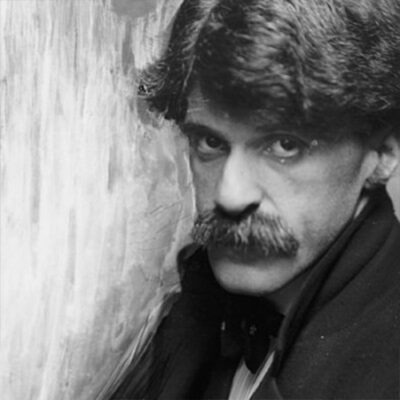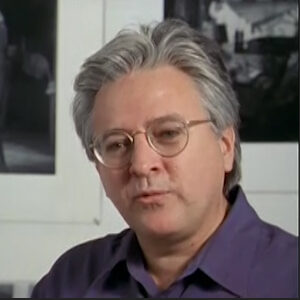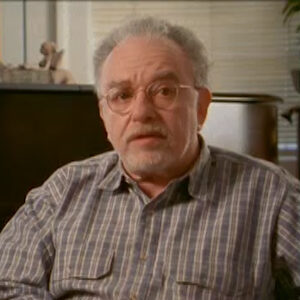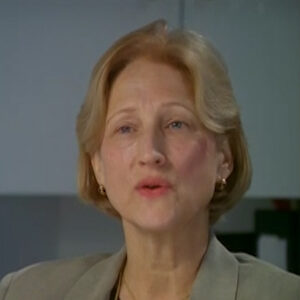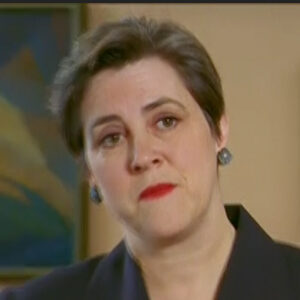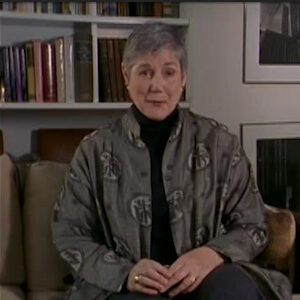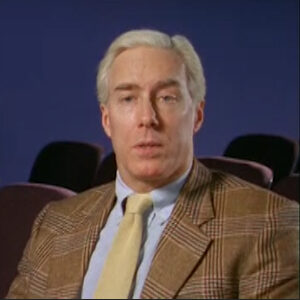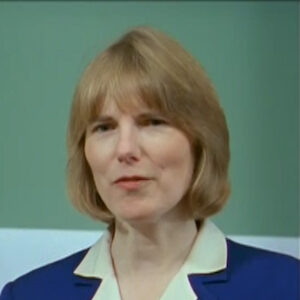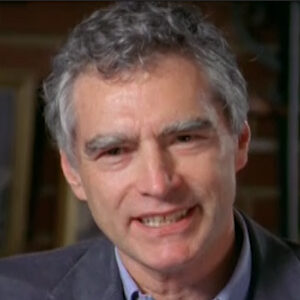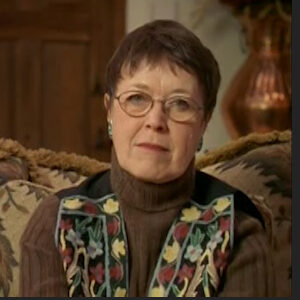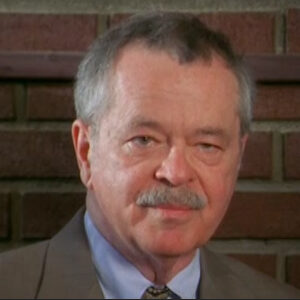Interviewer: Tell us a little bit about the way the way Stieglitz worked. Was there any difference once he got the gallery, the way he was working?
Lowe: Well, before he he was working in the gallery. He he was working on a magazine for the camera club. And he worked on the papers and so forth. The articles at the camera club, when he began to think about his own magazine, he was having trouble with a camera club. And he thought about doing camera work. His preliminary work was done on his home dining table with the men that he was used to working with at the at the camera club. And that was in nineteen two fundamental I or almost free here.
Interviewer: And Steichen was back and forth to Paris and did the designs at the end of the summer when he visited Alfred. And like George.
Interviewer: Let’s, let’s stop.
Interviewer: Let’s just cut rope.
Lowe: In the early part of of Alfred’s career in New York and in before nineteen two, he was working away from home. Then he in 1982 when he started to work on camera work. He brought his work home and worked on the dining table with his with his friends. But as soon as he had the gallery in nineteen five, he moved his energy and his days entirely to the gallery. He came home only in the evening after he’d spent a full day at the gallery and he did very little photographing again until about 1910 because he was working so hard on camera work and on the gallery itself.
Interviewer: It’s about.
Interviewer: The something about the competition with Steichen and Steve Steiger’s striker’s role went just so far. Tell us a little bit about Steichen, Steve.
Lowe: All right. When when they began to work together.
Interviewer: Tell me something beginning. So I hear the name Spikings.
Lowe: Right. OK. And in nineteen five, Steichen was planning to go to Europe and he had a studio at 291 Fifth Avenue, and he and Alfred had already been discussing having a place to show photographs because they couldn’t find space in galleries in New York. And they decided I Steichen was going, that they would start this photo gallery, the little galleries of the photo session. And fundamentally, Alfreds, who was there all the time, was able to take care of the selection of photographs and and also. Mustn’t be forgotten that camera work was in existence, and that was also the place on which the work was done. And after Steichen went to Europe, he became more or less the finder of of art materials, especially not photographs to send back to to ninety one. And both men, of course, took full credit for its being his idea, because each of them had that kind of a personality and denying that the other one had that much to do with it. But the fact is that that Steichen could have been his idea since it was his studio to have it in that spot.
Lowe: But they really collaborated. And for the first two years, they showed only photographs. And it wasn’t until nineteen seven that they began to show other of their paintings and so forth. And beginning with Steichen Choices of Roadsigns work in Paris.
Interviewer: Did about how long was Steichen closely involved in sending things? And then there were other people. Right. Like.
Interviewer: Desire, desire centered. And Weber, who got to tell me a little bit about, you know, the fact that he was very but certainly point he wasn’t in any more.
Lowe: Well, Steichen was extremely active in the beginning of this of this relationship and sending things back. That is artwork’s other than photographs from Paris to New York.
Lowe: And he he chose to show he had to he had arranged a group in Paris, younger American artists in Paris. And there were two or three artists in that circle whose works he wanted to send back, as well as Rhodanthe and gradually say, Tsan and my tese, he really chose to send back. But as Alfred became more acquainted with the modern European artists, Statens role diminished, especially after Alfred had at 291 a French supporter, Paul Hovland, who was well acquainted with works in in Europe and the cartoonist desires and desires and came into the picture, and especially Max Weber, who who joined the circle in 1910. Very briefly, but whose acquaintance with modern art in Paris was a great deal more than what Steichen had picked up. And Steichen role began to diminish severely so that so that he began to feel left out and was indeed left out. And many of the things Alfred continued to show his photographs and to start his photographs.
Lowe: But because he always respected him as as a superb craftsman, never no matter what their fight was, he always said he was the better one. But Stockton’s role in choosing modern art was severely diminished. And there were several of whom he disapproved. When Alfred chose to show Picasso, for instance, Steichen really didn’t like him. He didn’t like O’Keeffe’s work. And he removed himself really quite thoroughly from. From the choice.
Interviewer: Could you tell us what was the. Let’s go back to you, Stieglitz returned from Europe when editors, of course, of course, oppose it.
Interviewer: Tell us a little bit about what happened. He came back to give us a year or so that he returned and left you the words just eaglets. Yes, we hear the name. And he came back in 1890. Right, right. Right.
Lowe: Well, Stiglitz was called back from Berlin in 1890 on the death of his favorite sister. And when he came back to New York, he was really not ready inside of himself. But he realized he was 26 years old. His father had already begun to buy him a place in and a company reproduction company. And he was aware that the family wanted him to settle down and to be married. And all the rest, when he first came back, he was deeply depressed, very upset about what New York had to offer in comparison to what he’d been enjoying in Berlin. First of all, in in the nine years that he’d spent in Berlin, he lived in a sort of a very. A ferment of of ideas in the university world and and Berlin was an exciting place to be. And in those days, he was also very impressed with the cleanliness of Germany, with the conscientiousness of the workers, with their modesty. And he had all kinds of romanticized notions about Germans, as he had once had about Americans when he went to Germany. And when he came back, he found New York extremely dirty, noisy. And that was the thing that drove him maddest than anything, that things were changing in a way that he had at a distance thought was romantic. But it was too much to cope with this in the streets of New York. He was wild with distress. And the worst part of it was that he had no independence left to speak of. He was he had moved back with his family in the very traditional house with a very traditional household, though they were full of concerts and exhibitions and there was artwork around. It was still an atmosphere where he had lost the ability to be on his own.
Interviewer: Good. It’s good. Now.
Interviewer: He all right, he’s he’s tall. Now, tell us a little bit about the community of artists, his ideal and the connection with his family experience.
Interviewer: You spoke about his feeling about creating a community of artists exchanges that you think that is part of the enjoyment that he derived out of running the two ninety one and working on camera work.
Lowe: Was the sense of communal work with with his friends. And he had always dreamed of making that kind of community intersect to a great extent. To ninety one became that kind of a place where there was a free exchange of ideas, where everybody was working as hard as he could to do the best that he could, always working for perfection, where though there was disagreement, but it was always somehow or another resolved so that they remained friends. And this was a kind of ideal that really went back to his roots and his father’s home, because Stiglitz grew up in a home where his father, who was a very successful merchant, was getting really very tired of this of this commercial life and was himself a painter taking taking lessons as a painter and had a Sunday regular dinner for up to 30 people were who were not businessmen. They were they were artists. They were Jurnee journalists. They were writers. They were actors. They were teachers.
Interviewer: Twenty seven, take twelve.
Interviewer: To where it was last time. OK. It doesn’t go OK.
Interviewer: It’s just a little more about its father.
Lowe: He was particularly fortunate. I think, in having a father who was not only a painter and who liked this this kind of life, but also in the fact that that his father was very generous with artists they had in succession to major artists who lived with them for a year. Moses, Zeke Hill for a year, who was a sculptor who did sculptures for the Corcoran and and Fada anchor, was a painter. And he supported Edward, that is, the father supported both of these artists in their studios after they’d lived with him, one in Paris and one in Rome and and went around traveling to get solo works and offered. Of course, then grew up in an atmosphere of respect, active respect for art so that it was a natural thing for him to feel that this was something that he could carry on. He really he adored his father. In most ways, though, they disagreed about some aspects of life. But in most ways, he adored his father and he was his father’s favorite, though he never liked to tell the world that somehow or another, he managed to convince his contemporaries and the people who came to visit the gallery that he was sort of a waif that this family had sort of taken in. But he really wasn’t affected by it. And that everything that he come by, he had come by through his own efforts and so forth. I think romanticized himself. I think we’re matricide everything. And so his his picking up, his becoming as his father was a kind of people collector. He was always interested in what other people had to bring to him and always curious, and he was as well as a as a great talker. He was also a wonderful listener. When he was interested.
Interviewer: I’ve lost one, could you could you tell us.
Interviewer: Now that we’re on that.
Interviewer: The fact that he’s known as a great talker for 14 hours. But he also was a great you know, very well, I just didn’t say what did he say, Steve? All right.
Lowe: Right. Right. Stigler’s had a reputation, which was a correct one in public for talking endlessly. And he did in his galleries. And his it was a kind of rolling monologue that included all almost all of his own life experiences, almost everything that he had learned along the way. And often some opinions that people didn’t agree with at all. But he was very convincing. It was almost seductive in his conversation. And people either adored it or hated it. And the thing that most people don’t know about him is that he was capable of being an extraordinary listener. He he really empathized with somebody who had problems to tell him or simply wanted to tell him about their experiences. If he responded to somebody. It was it was extraordinary what what he would listen to and really listen to and the interest that he took. Who is it?
Interviewer: I’m sorry I cut you off there. Could you could you put it in personal terms that you could talk in so that we identify you?
Interviewer: All right. You told me that you could anything.
Lowe: Well, fundamentally, I also because I grew up with the family. He and I, Stieglitz and I were were acquainted with each other. He from that week that I was born and I from the age of two and a half to three quarters, something like that, until he died nineteen forty six and saw each other very frequently. And like George. And at the galleries in New York and in his later years at the penthouse where he and O’Keefe lived. And one thing that was amazing about him, I perhaps didn’t take as much advantage of it as as my cousins and my sister and so forth, was that he was always interested in what we were thinking and what we were doing. And you could tell him anything. In fact, he was he was delighted if you told him everything. I wasn’t ready to tell him everything. And and once in a while, our our opinions about how much I was willing to divulge differed a little bit. But he was absolutely interested and he thought that he had a great deal to teach about life. He did. And in perhaps a more limited sense than he thought. Because it’s it’s hard sometimes when somebody believes that they really know everything to listen to everything that they have to say. And so I’ve I think I withdrew a little bit from the monologues and so forth. I attended quite a few sessions at Lake George when I was in my teens when they were visiting artists and my father was living there. And I heard these circular arguments going on that so tired APF she really got so sick of his words that she withdrew really quite early on from the major conversations and so forth, eventually gave parties for him and for the artists in which the food was there. She greeted everybody and then she went off to a concert.
Interviewer: Did you. You said something about that he could be that what you asked?
Lowe: If you asked his opinion from your work that he could be very, very tough and very ruthless about something.
Lowe: Well, the. Interesting thing about Stigler’s is honesty with people was that it was pervasive. He was he was a good listener. As I said, he was able most of the time talking about life’s problems, of of being very gentle in his responses and so forth. If somebody came to him to ask his opinion of the work that they were doing, he was also honest. But it was sometimes brutally honest. And he felt that it was it would it wouldn’t contribute anything to anybody’s growth unless he told them absolutely what he felt about something. And he dissuaded a great many people from continuing as photographers or painters. And of course, he he eventually he lost some of the influence he had had on people who had been around him for a long time because they got a little tired of his expressing himself so hard. He was not hard, however, on the artists who were very close to him. He he never told, so far as I know, any one of the artists, Dove or Marin or Hartley, perhaps hardly a little bit, because he wanted to disabuse him of doing so much work out of the country when he thought he was better in Maine. But they generally speaking, he never imposed himself on what they were doing. What he was interested in was that they were bettering themselves all the time, that they were experimenting all the time, that they were always doing the best that they possibly could. And he was genuinely interested in that. And that’s the one thing I think, that really kept him and O’Keefe together. Was there mutual respect for each other’s art and the conviction that they could really depend on each other to the to the last degree for honesty, which meant so much to both of them?
Interviewer: Good cut. Is that right? That’s wonderful. That’s wonderful. Two minutes.
Interviewer: It. When they start.
Lowe: When the First World War began to engage America, there, there came this was this coincided with the end of the magazine camera work, which of which many of the illustrations had been printed in Germany.
Lowe: It also was a very difficult time for Alfred because the magazine itself, which had started out in 1982 with with a thousand people signed up to receive it by the time 1917 rolled around, had thirty eight subscribers and they paid the subscriptions had fallen off because he was showing more and more of the other arts than photography. And most of his subscribers had been photographers who put him into a very sad situation. He had also lost to. Europe, two of his mainstays in Havilland, had going back to France. And I’m trying to remember who else it was, but there was somebody else who had left again. And he was feeling deserted at two ninety one. Can’t you. Can’t be. I was in and out. It can’t be. I came back again. Well, sorry I’ve ruined that one. And his his sense that he really was alone. And every way was very strong because, amongst other things, people were involved with the war. He had been extremely pacifist in his attitudes, and this was partly because some of the people who came to ninety one were deeply involved in pacifist movements.
Lowe: And and he felt that war solve nothing except for a brief moment when he sort of thought and Bagneris and turned.
Interviewer: We’re talking about the war years. Yes. And something about the last time he was pacifist but anti-war, not quite a pacifist, an anti-war. That’s, you know, that’s. But the debate with Steichen during the war.
Interviewer: OK.
Lowe: All right. During during the war, actually, there was a there was a break between Stieglitz and Steichen that originated a large part of it, at least from the fact that Steichen was so thoroughly anti German. He’d been living in France for most of the time between 1982 and 1914 and with his with his new family and was very much a Francophile. And it was extremely offensive to him that Alfred continued to stand up for the Germans. I should I should take off the the plural, because it was he stood up to the German in a way of admiring the German character and so forth and the things that he had so enjoyed when he was a student in Germany. And they differed entirely about that. And there was a break of his sort already when the Lusitania was sunk because Stieglitz said.
Lowe: They were in the way they’d been warned it would be sound they shouldn’t have they shouldn’t have sailed, and it was fundamentally their fault for getting in the way. And of course, this is not the worst I can read it at all. It was simply outrageous that the Germans had had sunk a ship which was carrying civilians and so forth. But it came to a head finally in about 1917. And the curious thing about it is that Steichen. Was.
Lowe: Interested in immediately. I think when the Lusitania was sunk, he decided he was he was going to enlist right away as it was kind of take that Stieglitz.
Lowe: Because he couldn’t go into service for some time and eventually he wound up in charge of aerial photography in in Europe. And this was, of course, something which fed his career immensely. And Alfred, there’s a certain point really got kind of jealous of that. And he he remarked about how handsome Steichen looked in his uniform and how this was sort of attracting the ladies size and and pleasure. And he he thought if he’d only been younger, he, too, would have looked handsome in his uniform. He said as much. And there was a time actually toward the end of the war when he wanted to to play a part. He hit his his brother, who was a chemist, was in touch with the war department and said that Alford could could play a role and he was interested in that and maybe Keith could be a nurse. I mean, they had all of these all of these plans, of course, virtually at the moment when the war was over. But the break with Steichen had already come because there were many other issues between them. Amongst them, there was the difference in age.
Lowe: Wednesday, Steichen at first appeared on the scene, Alfred was 35 or something, and Steichen was maybe 15 years younger. I’m not sure of that, but something like that. And so that Alfred could enjoy feeling fatherly toward him. Later on, as his as he became he came into his 50s. It was not so much fun anymore to be the old man. And he was jealous of Steinman’s youth. There wasn’t any question about that. Also of the breadth of his experience, though, he himself wouldn’t. Venture into many of the things that Steichen I’ve been doing just the same. He he wanted to have that that youthful splendor returned to him.
Interviewer: It’s interesting.
Interviewer: There also was a kind of a basic yes to leave later, basic difference in the fact that.
Lowe: It’s true that he made money and that’s that this I really intended to get into. I forgot the other. The other major difference between them and it started really quite early. Was that Steichen, who had grown up without any resources to speak of, needed to make money out of the work that he did. And Alfred did not. Alfred was supported by his father. He had an allowance from him until his father died, at which point his brother picked up giving him money. And he still had a little bit left from his father. And so he could be a purist about never making money out of art. And he was very strong about that. And the Steichen was equally strong.
Lowe: You said that Alfred was never really developed himself as far as he should have because he he didn’t have to sell his work. And Alfred, on the other hand, said that having to sell your work ruined your work so you weren’t able to grow in the same way. And this was a very, very strong point of contention between the two.
Interviewer: There also wasn’t there also a lot of resentment that.
Lowe: Stieglitz felt that he felt that he was selling out, that he was corrupting the community of what they had worked together. And he didn’t didn’t want to be very critical of the fact that Steichen was doing the work.
Lowe: Oh, yes. But this was this was I think, because he wanted to continue his his influence on Steichen. And this was something that was that was very interesting about everybody with whom Alford worked, whether it was in the production of a magazine and writing the people who came to ninety one, the other artists who came. Was that though he viewed himself as a teacher. He was never able to take pride in his students. When they left him, having absorbed his lessons, they had to grow away from him. And he never recognized that he felt always as though he was being betrayed. And this was this was great drama because he had given them everything that he could. And then they left him and they and right and left. And they said terrible things about him. He was very possessive without knowing it. And all of his work was I would say that there was a considerable difference between what he knew of himself and where he was subconsciously, so that so that he he was aware only that he was helping everybody to grow. But he had never acknowledged when they had grown.
Interviewer: That’s very interesting. Very, very interesting.
Interviewer: Could you could you tell us something about the.
Interviewer: O’Keefe. And the fact that you’re the role that you’re that your mother and your family played in bringing O’Keefe that they knew.
Interviewer: She is situation.
Interviewer: Can you tell us? She was also critical of the war propaganda. She was in good health. And you have to do something about the Yoki and these guys story coming to you.
Lowe: All right. There was there was a time in my mother’s life. Very, very early on, actually, when she as sort of Alfred’s favorite niece and very much influenced by the drive toward the arts, was herself a painter and a violinist. And at his suggestion, went to study in Europe and came back and was filled with also with all of his attitudes about art.
Lowe: And when he was as enthusiastic as he was immediately about O’Keeffe’s work, when you saw it for the first time, mother then played into this enthusiasm with with great pleasure. And at when she came back from Europe, or actually just as the war broke out or as America became more and more involved in it, she her father treated her to a studio on on East Fifty Ninth Street where she could paint and practice her violin. And Alfred, who had been worried about O’Keeffe teaching in Texas and also not in very good health, she got the flu, as a matter of fact.
Lowe: And of course, that was a terrifying year of enormous decimation of of people by by the flu epidemic. And also that she was having difficulty in and relating to people around her because she she had a forward looking sense about about art. And in the small town where she was teaching as she was, she was not looked upon in a friendly way. And I’m a persuaded my mother that if O’Keefe did come to New York for a year without having to worry about.
Lowe: About where the money came from, how she could stay in my mother’s studio, that would be a wonderful place because mother is still out of place to live in with her family. And wouldn’t that be great? So this this was one of the things that that kept the two of them together and trying to get O’Keefe to come to New York. The other was that each of them had fallen in love. Stieglitz with O’Keefe long before she knew about it. And my mother, with another outcast from the Stieglitz family, who was a Scottish artist who had had a great deal of money in his family at all.
Interviewer: Oh, hey.
Lowe: Why is that OK? When my my mother and Alfred were really working together to get O’Keefe to come to New York and Mother had even started a correspondence with O’Keefe, and O’Keefe later wrote that that was just so much she just couldn’t imagine so much coming from this person. In any event, what happened was that Alfred was able to persuade O’Keefe to come to New York, presumably for a year in which she would support her and my mother would give up hers, her painting studio to O’Keefe, and that she would be comfortable and everything would be taken care of. And he was he was able to accomplish that. She she left Texas, where she’d been teaching and came to New York with his promise. And she was apparently just getting over the flu when she arrived in New York. And he mother hands her to death. I mean, he was he didn’t know anything about taking care of anybody. But I think he could boil eggs, whatever it was, he brought things to her. And in a very short while, he left his wife to move in with Keith. And this was something that was that was wonderful so far as my very romantic mother was concerned, who was trying to do the same kind of thing with this Scotsman that she was involved with that her family didn’t approve of because there wasn’t any money. And at about that time, she was already in this in this very arty look. She was teaching at the art students league and she was enjoying all of the look of the period. And Alford was very proud of her. I think in some ways more proud of her than he ever was of his daughter because she was really his devotee and and he knew it. And his daughter, who had been carefully handled by his wife, was quite out of the picture. And when Oki’s came to New York and mother left the studio to her within a month, Alfred was living in the studio with her. Two had left his wife and their life together had begun. I know I’m lost. I don’t know where I. That’s OK. Yes. I go into the picture.
Interviewer: Hold on a second. OK.
Lowe: I actually never asked O’Keefe directly to come to New York while she was still teaching in Texas. He said of prepared the way, but he wanted it all to be her impulse. So he told her what would be available to her if she came to New York, that she would have a year in which to paint it for and that she would be left on her own. She wouldn’t have to worry about earning anything at all that he would provide all the money for her and that she would have a place to live. That was her own and that it would be my mother’s studio, which she’d already arranged with her. But he didn’t try to persuade her outright. He said, these are available to you. Now you decide. He even sent Strand to Texas to accompany her back without without saying the strain. Now you persuade her. This is it has to be her decision. Absolutely. Which it turned out to be. And he didn’t tell her until until she was living in New York that he he would support her in the way that he did immediately. When when he moved in with her, he didn’t say he was going to move in with her. This was something that happened.
Interviewer: No, I’m lost again. Tell us something about the about the show, the. It was 19. It was 19. Twenty one. Was it the first show? The first show that the first showed. Stieglitz showed his pictures at the end at the embassy. Right.
Lowe: Right. When when Stabler’s lost his his to 91. Gallery in in 1917. And he didn’t know if he was going to run another gallery. Whatever he was going to do. And then O’Keefe arrived. And the concentration was on her and his photography. Then immediately sprung into a whole new period. And he took hundreds of pictures of her. And then after. As this entrepreneur, after a couple of years, he wanted then to show these pictures as well as other ones that he’d been taking in that same period. And he arranged with the Anderson Galleries, which was a huge auction house fundamentally to write up what turned out to be almost a floor for an exhibition in 1921 of the it was 1920, one of the. Of photographs that he’d been taking since fundamentally since leaving the two ninety one his own gallery. And this included a large collection of photographs that he had taken of Keith. Mostly nudes, but not all nudes. Some of her hands. Different parts of her body. Some that were draped. Some that were sullen. Not. Nothing really that I recall that was smiling because it was extremely difficult in those days of of slow action film to take a smile that didn’t look like something totally idiotic.
Lowe: So almost almost all of the pictures that he took of her are quite solemn. And they weren’t they were taken with a large camera and long pause. I mean, poses she had to stand still sometimes for over a minute, which was extremely difficult for her to do. And this show was an absolute blockbuster. He was introducing O’Keefe to the world as a nude largely and and a large number of the photographs that he took of her had sort of fuzzy background of her own paintings. So he was he was introducing her painting as well, which is what he he did deliberately as he wanted to introduce her as a painter. And the and the show was an absolute blockbuster and terribly difficult for O’Keefe. She’d had no difficulty whatsoever, apparently, and posing for pictures. She said she you know, she felt as though, well, she was helping him with his art. He was helping her with her art. And that was that wasn’t so difficult. And she felt almost disembodied in some way. But when the public reaction concentrated on her nudity and so forth and started to interview her in terms of what she was going to reveal of herself to the world and all kinds of extraordinary things which was spoken about the two of them, this made her extremely uncomfortable and made her really withdraw as much as she could from having anything to do with the press. And it was only only under great duress that she was able to be brought forth again when she had shows or so forth until quite late in her life. She had a very hard time.
Interviewer: I. OK.
Interviewer: Uh.
Lowe: They were they were they were ruined. I like the fact that you say that this is his description. But anyway, women who saw the principal with something that the public at the ready you were all.
Interviewer: Far away with it.
Lowe: We’re all sort of astonishingly women who came to this exhibition with with largely nudes of of O’Keefe. I asked to have Alfred take their picture. And even even their husbands did because they felt that this there was a kind of intimacy that was also respectful. And what was there now? It’s it’s odd. It’s possible that Alfred exaggerated how much they wanted these photographs to be taken to their wives. But he said, obviously, I can’t do that because I don’t have the relationship with your wife that I have with OK. But they made a huge impact. And he did have many requests for portraits. Which you’ve mostly turned down.
Interviewer: Tell us very, very briefly, because I have some other people doing it, too. O’Keeffe’s O’Keeffe’s reaction of how would she? Was she going to be taken seriously as an artist? If they are, they identified her as they they were the sex gods. Right.
Lowe: It was difficult, I think, for O’Keefe to be seen as this nude, but since or largely nude model for his camera.
Lowe: But since so many of of the photographs of her also included some part of his painting. And he emphasized the fact that she was a painter. And in their next exhibition at the Anderson Galleries, he had one gallery and she had her debut with 100 photographs of it. These were, I mean, paintings. So these were shown simultaneously. And she had really her her debut as a as a painter at that at that time. So and he was he was very careful always to say when he presented her photographs and in whatever dress that she was the woman painter. This was never was slighted in any way at all. And I don’t think she could have objected to that, except that she never wanted to be associated with being a model because that in some way or another diminished her standing as an artist or so she felt. And I think it was very difficult for her. And of course, because she had been presented first as a nude, the press never left her alone thereafter or Alfred.
Interviewer: I’d like to talk a little bit about the.
Interviewer: The clouds and you spoken about the deep reason for Alfred’s journey to a club that that summer. And his feeling about his mother’s illness.
Lowe: All right. In the in the summer of 1922, I think it was 22.
Lowe: Yes, yes. He died in the fall.
Lowe: She died. Well, it was I think the first of equivalence were two years before.
Lowe: I’m trying I’m trying to get my dates straight at the ads in the early 20s. His mother, to whom he was very attached, had a stroke and she was living at Lake George. Then they had sold the place at Oaklawn. Everybody moved up the hill to what later became the sole residence.
Lowe: And in the in the first summer of her illness, he was. He was rather distant. And Ruffy always found other things to do. And she was she was very upset by his reaction. She got over the stroke gradually. And they sort of made peace by the end of the summer. But the second time that she had a major stroke, which was in 1922, he began to photograph clouds. Now, it’s it’s interesting that he spoke of it to the people around him and so forth as an experiment with music. Because he was very musical. A pianist from from his very early days had.
Lowe: Been thinking about how to photograph something other than people’s faces or landscape or. And and to express himself somehow. But the fact was that it was more than that. And it was it was a couple of years before he was able to describe it to one of his colleagues in England. As having been kind of transmogrification of his. His sorrow, his fear about his mother, who was obviously dying. And that he he was unable to focus anymore on what was immediate. He had he had to find something which was dist. so that he could he could create some kind of emotional distance for himself. And in that summer, his relation with his mother was tender. And completely warm. And he and he was with her at any time that she wanted and played music on on a Victrola and read to where and did all of these things because he’d found a way to express his deepest emotion in a distance. And it was it was very this was the beginning, really, of his cloud pictures.
Interviewer: That’s that’s very interesting. That’s very, very interesting in the interpretation that they were.
Interviewer: You said that they would forward a release for him turning away to the sky. Yes. I.
Interviewer: Where’s the picture?
Lowe: Which one? Oh, that’s. That’s in here. I can’t. It’s amongst these. You don’t have to pick this up. So I don’t know if I can get up with what I have on my back here. I don’t know if it’s it’s in a gel out there. You know, we’re rolling for ourselves. OK, sir, you want me to bring this out?
Interviewer: Oh, yeah. Yeah. And you mention that he took this picture of his mother just around the time.
Interviewer: All right.
Lowe: Just before her final stroke, Alfred took a picture of her on me on the porch of the farmhouse where where to which everybody had moved. That has a kind of delicacy of feeling that was not true in pictures that he took two years before. And it’s really very interesting because here it it really shows that he’s sort of come to terms, in a way, with with her. Being out of his life.
Lowe: I am lost. You quoted something to me that I that I’ve forgotten the photographs, I think upon release.
Interviewer: Okay. Okay.
Lowe: I think his his photographs of the sky soars. It’s OK.
Lowe: I think the photographs that he took of the sky beginning and and especially those in the year in which his mother died in 1922 were a way of his removing himself from the deterioration that he saw all around him. That was that was connected to the earth. The old chestnut trees, which he had adored, were dying. There was his mother who was ill. The sense of of the old coachman was was getting tired and and wouldn’t be able to work anymore. And everything that he had connected with his youth was beginning to disintegrate. So he found a kind of release in the sky and a concentration where there was there was a wonderful dance of clouds. In fact, he he called the first cloud series music. And and he thought of it deliberately as that. But it was also a way of removing himself from the pains of the earth.
Interviewer: Wonderful, wonderful, wonderful.
Interviewer: Why, after living together for six years, did keeping secrets finally get decided to get married? Was it her idea?
Lowe: The decision to get married between O’Keeffe and Alfred is still a puzzle. I’m not absolutely certain. I tend to think that it it hinged on something so minuscule as having to sign a lease somewhere. They had been living in my grandfather’s house undisturbed. Having a Florida themselves and able to entertain as many people as they wanted for four years. And my grandfather then was selling his house and they were forced to move. It was also the year 1924 was the year that his wife finally gave him a divorce. It had taken six years. He’d asked for one immediately, but she wasn’t granted. And that was in October, I think, or September. It became the decree became final. They weren’t allowed to marry in New York State. They had to go to another state to get married. But that’s fundamentally what happened.
Interviewer: But he she said it said she didn’t she didn’t want to get married. She did not. Not anxious to get married.
Lowe: I don’t think either of them really were anxious to marry, except perhaps that that Stieglitz was more interested in getting married than she by the by the sense that he was getting so much older and she was still a young woman. So it was a way to to hang on to her. But that was even subliminal. I don’t I don’t think that was.
Interviewer: I think we can we can mention it. I may cut it all right.
Lowe: There came a time in the relationship it was OK.
Interviewer: OK. All right. Are we on speed? Yes. OK. OK.
Lowe: There came a time in the relationship between Alford and Georgia significantly after they were married. I think I think in an odd sort of way that that made some new parameters to their relationship. When when O’Keefe became increasingly fed up with like George Summers, where she felt constricted, she felt there was too much family around. She she didn’t. She didn’t. And and the. The scenery itself was too limiting.
Lowe: It was too close. It was she missed desperately what she had had in Texas with with the Great Plains and even from her childhood and in the plains, the northern plains. And she had she had a need to get away from from Lake George, which was in its own way, extremely ingrown. The Stieglitz family had their own compound. You hardly had anything to do with the surrounding world.
Lowe: And at the time that she wanted to go, both of them had been invited to go west to go out to New Mexico.
Lowe: And Alfred, who had already suffered a major heart attack and who was terrified. Thanks to my grandfather’s doctoring of of going up. I think 12 stories, let let alone thousands of feet, was persuaded that he couldn’t go. And O’Keefe went and adored it had had freedom that she hadn’t had for years. And in space, as well as an emotional concentration. And she began to feel that she had to be there every summer. And he at first, of course, objected.
Interviewer: I think it’s demented that she gets. Christine, don’t flush the toilet.
Interviewer: OK. Hold on a second one. I thought it was really worth.
Interviewer: Yeah. Let me go. OK.
Lowe: There came a time in the summers which were the working times for Alfred and O’Keefe at Lake George, when when O’Keefe began to feel extremely hemmed in somehow or another, the leakiness of it began to to impinge on her sense of freedom. And I think obviously also the presence of the family for most of the summer, except for a few weeks before a few weeks after the family was there, when she and Alfred were able to work without the presence of these irritating characters. And she began to feel as though she had to get away. She absolutely had to get away. And they were both invited by Mabel Dodge, who had to go out to New Mexico to stay at her place and to follow he to photograph and Georgia to paint. By that time, Alfred had already had a significant heart attack and he was terrified about going to higher altitudes. But and she wanted to go desperately, wanted to go it was country, after all, which in a way she was familiar with from the time in Texas, and she great openness was something that she was dying to have. And she went at first with with his real grudging attitude. And he missed her desperately. And I’ve seen Rohter volumes all the time and was terrified when she didn’t respond. And she went off on on a little camping trips and was away for a week. And he was almost suicidal. I mean, it was the storeman drawing was absolutely tremendous. And she came back refreshed and in love again and. Oh, and everything was wonderful between them. But this happened again and again until about nineteen twenty nine. He he really felt as though as though she were deserting him all the time. Then gradually he began to say that he was very much in favor of her going. That it contributed to her growth as an artist and that it certainly did. She had a kind of freedom that she sought from then on. I don’t think either of them thought in the beginning that she would be spending virtually five months a year in New Mexico. And certainly he didn’t think that was going to happen. She only she only changed that, I think, twice when he had been extremely ill and she took care of him. And another time when she was ill.
Interviewer: What do I left out? No, that that’s that. That’s that.
Interviewer: That’s fine. Norman. I think that if you are a little bit about the dirty Mormon thing, I mean, Dorothy Norman, what was her her role sort of with his work?
Interviewer: And then somebody said, well, she was so devoted because they had had this great love affair at one point. Tell us a little bit about sort of vice versa. But that’s our.
Lowe: Out of a period in nineteen twenty four, somewhere around there, there appeared in his second gallery.
Interviewer: His latest is it was nineteen twenty five.
Lowe: Twenty six. You’re right. Yes, you’re right.
Lowe: Well, I’ll just say in light.
Lowe: In the late 20s and the late 20s, when when Stieglitz was running his second gallery, there appeared a young woman who was just enraptured by everything that he had to say.
Lowe: He had this skill that went on and on and on and on and on and covered every every little bit of life, his own other people’s philosophy, music, whatever came, it just it unreeled all the time.
Lowe: And she was somebody who was completely captivated. She was very young. She was in her early 20s. And she practically sat at his feet in the gallery. And this was, of course, extremely flattering. And he began to take notice of her and to answer. She wrote to him all the time. She was married. She was expecting her second child pretty soon. And he had he was drawn more and more to this person who was so connected with his, if you want to call it intellectual life, which which O’Keefe was not. That he he began to encourage her sort of sitting at his feet and she began to do things at the gallery. And she O’Keefe took an instant dislike to her. This was this was. And that never changed. And stayed away from the gallery more. And so Alfred had sitting at his feet. This young lady in her 20s when he was in his 60s and admiring everything that he said. And it was very seductive in its own way. And by nineteen twenty nine, I guess it was. She became Dorothy Nolan became more of a figure in his life. What as O’Keefe withdrew more and more. She wouldn’t come to the gallery anymore except to hang shows at which she was non plus ultra ultra. She was just incredible. And they were beautifully shot. But she wouldn’t set foot. She didn’t want to see Dorothy Norman anywhere. And so it began as as I think they were both kind of amused with this young lady to begin with. And then gradually, Alfred’s was so flattered by the attention that was brought that he began to take her more seriously.
Interviewer: You think that they. Do you think that they did and. You said something that was sort of ambiguous.
Lowe: Well, I think to which time no, no.
Lowe: As Dorothy Norman wrote and spoke all the time about their love affair and Alfred spoke about their love affair. And it’s always been a subject that I have not quite been able to resolve in my own mind. I think they both romanticized, unbelievably, what their role was in each other’s lives, whether it was physical or not. I mean, this is I really couldn’t care less. I mean, it pulled all of their emotional expression out in front. And, my God name wrote each other letters that were just incredible. And he photographed her all over the place, including some news.
Lowe: And and O’Keefe at first began to think, well, you know, I’ll write it out and that’ll be OK. And eventually she had a breakdown. And after that, Dorothy Norman heard her role in Alfred’s life changed entirely. She was continued to be a supporter of the gallery in terms in money terms as well, because she had an extremely wealthy husband and. But otherwise, it was damp down. And he returned really entirely to Keith.
Interviewer: She wrote a lot about it, didn’t she? She was a kind of biographer.
Lowe: Yes, she wrote. She wrote the first. I’m fundamentally a sort of artistic biography of Alfred and he and she wrote about him for the magazine that he helped her to start, called twice a year and in whatever vain, wherever she was working, there was something that she’d written about it. And he used to use her her descriptions for the.

